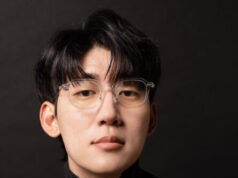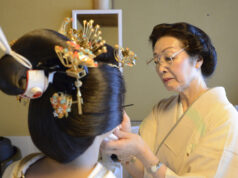Bruce Miyahara — “OG-San” Marries Food Passion with Service
By Elaine Ikoma Ko
For The North American Post

Introduction
Seattle’s Bruce Miyahara has reignited a new passion in his retirement when most people ride off into the sunset. Bruce’s Seattle roots have taken him from being the first director of the International District Community Health Center to, decades later, becoming a passionate volunteer cook at Seattle’s Kamonegi restaurant. Today, he has inspired a pay-it-forward “Rice for All Collective” project to help community elders secure healthy Asian-inspired meals. The “OG-San,” his social media moniker, is from “ojiisan,” which in Japanese, means uncle or esteemed “old man.”
Bruce Miyahara
@older_than_i_5_OG-san
Aging in Program of All-Inclusive Care for the Elderly
https://www.aipace.org.
@rice_4_all_collective
bmiyahara@mac.com
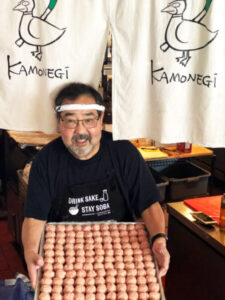
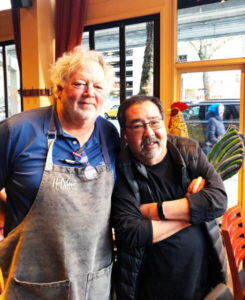
Tell us about your Japanese grandparents from Japan and your parents growing up in Seattle.
ーMy paternal grandparents, Kiyoichi and Kiyomi Miyahara, immigrated from Hiroshima. They had three children: Hiro (my father), Tak Miyahara, and Leah (Miyahara) Sakamoto. My father and Uncle Tak were born in Olympia, Washington, as my grandparents worked on an oyster farm there. It seems that early Japanese settlers were involved in the local oyster farming business, which is also an important industry in Hiroshima.
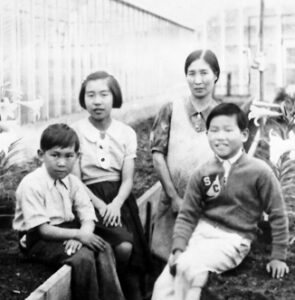

My maternal grandparents, Kikujiro and Riki Mano, immigrated from Shizuoka, Tokyo and Chiba. They had three children — Kiyo (my mother), Tosh Mano, and George Mano, all of Seattle. Riki died from tuberculosis when my mother was a child before the family was sent to Minidoka incarceration camp. Later, my grandfather married Tase Takahashi after release from the camp.
My maternal grandfather had a greenhouse in Seattle’s Green Lake area where he grew flowers and vegetables to sell at Pike Place Market. He later built Earlington Greenhouse in the Skyway neighborhood. We lovingly referred to my maternal grandparents as “Greenhouse Jiichan and Baachan.” My Uncle Tosh continued to run the greenhouse until he retired.
You grew up in downtown Seattle. What was that like?
ーOn social media, I call myself “older_than_I_5_OG_san” as I am older than Seattle’s I-5 freeway and we lived right next to it before it was built!
My paternal grandparents left work on the oyster farm to manage hotels and apartments in downtown Seattle. Their first was an old hotel on First Avenue above the old Anchor Tavern. I remember their stories about dealing with corroded bathtubs from the Prohibition Era (1920-1933) when bootleg gin was “produced” in their hotel. Later, they managed the New Latona Hotel on First Avenue across the street from the current Crocodile (First Avenue at Wall).
Until I was in elementary school, we lived in the Manhattan Apartments, across the street from Market House Meats (Howell Street at Minor Avenue) which set a very high standard for my taste in corned beef! This is where the current Metropolitan Park buildings are located next to the freeway. We were right next to the Smith Gandy Ford dealership, a busy commercial area. I learned how to ride a bicycle in their parking lot.
As my young neighborhood friends started moving away, we moved to the Summit Arms apartment, on Summit between Pike and Pine Streets, around 1956. Shortly after, the neighborhood was dug up and the freeway started going in… all through Seattle.
I learned later that there was strong Japanese-community business support and financing assistance for the Japanese who owned hotels. A lot of my friends lived in, owned or
managed apartments, such as the Fujii, Okamoto, Tanaka, Tanabe and Harada families.
When we lived downtown, I loved shopping with my mom at Pike Place Market and visiting her stepmother’s relatives, Seiji (Curly) and Pete Hanada. They had a vegetable stand in the corner by the current “Rachel the Pig,” across from Pike Market Fish; Seiji is pictured on a plaque next to the elevator on Western Avenue. His daughter, Diana Kuzaro (Hanada) married Donnie Kuzaro of Don and Joe’s Meats, also in the market.
Most shopping days also included visits to Mutual Fish, then on 12th Avenue, or Uwajimaya in the International District (ID, its earlier name). On lucky days, we’d have lunch at the now-closed Tenkatsu restaurant (South Main at Sixth Avenue South).
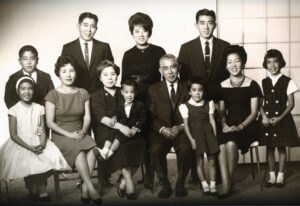
Tell us how you became the first Director of the International District Health Clinic in 1973 and launched your career in health services?
ーWhen my family moved to the Beacon Hill neighborhood, I went to Franklin High School. I played in the first Franklin Jazz Band and later, some of us started the “Nine Lives” band, which became quite popular locally and across the state.
A fun side note: After I left Nine Lives, I sold my trombone to Terry Takeuchi, of today’s Terry’s Kitchen restaurant (napost.com, Mar. 2022; Soy Source, June 2023), so we have a long history together!
I started at the University of Washington (UW) studying pre-medicine. After I cruised through pre-med, I studied architecture, biology and botany. I took first-year medical school classes through the Equal Opportunity Program (EOP, which has helped under-represented ethnic minority, economically disadvantaged and first-generation college students at UW). But none of that stuck.
While I continued to play in Nine Lives, I also continued to have an interest in the medical and health field. I began volunteering at the Asian Community Health Clinic, a free weekly evening clinic on Beacon Hill. There, I worked alongside Janyce Ko Fisher, who today has a gallery named in her honor at International Community Health Services (ICHS) in Shoreline, Washington.
The mission of the original clinic was to provide bilingual services to overcome income, insurance coverage, cultural and language barriers. Some readers might remember Dr. Eugene Ko’s Jefferson Park Medical Clinic (near today’s Beacon Hill light-rail station). He donated the use of his clinic for a group of Asian physicians and nurses to provide free medical services.
During that time, I was also volunteering in the ID, a neighborhood steeped in historic racism, which was being challenged by large development projects. By then, the incarceration of Japanese Americans had already decimated a good portion of Japantown and I-5 had cut the neighborhood in half. Huge infrastructure projects such as a multi-modal transportation terminal and Kingdome Stadium threatened the neighborhood’s survival.

At the time, there was a large group of activists that united to help on every community project no matter who owned it, which in my view, was unique. One of the most memorable food-related projects was helping terrace the Danny Woo Community Garden. It hosted the first community pig roast with the legendary “Uncle Bob” Santos. As with most ID program start-ups during the 1970s, a beer with Uncle Bob in the Four Seas Restaurant bar (present location of Uncle Bob’s Place) turned into a plan.
The plan for the Asian Community Health Clinic was to transition its volunteer efforts to a more permanent organization, so funding was sought to expand the efforts. We started out with funding from King County Council Member Ruby Chow, Community Development Block Grants through the City of Seattle, state funding, and a Nursing Research Grant assisted by Sister Heidi Parreno, who later joined the staff.
The original clinic was built at a gambling hall that Uncle Bob helped secure next to the old Kokusai Theater (Maynard Avenue South; present location of Northwest Asian Weekly). Architect Joey Ing designed the clinic on the back of a cocktail napkin. Later, the construction was led by Kaz Ishimitsu (of Ishimitsu & Sons, building contractors).
I became the first Executive Director at the International District Community Health Center, which later became International Community Health Services (ICHS). From my experience as the first director, I found my health systems interests were in policy and management. Accordingly, I entered the UW Masters of Health Administration and Planning program. After graduate school, I began work at the Seattle/King County Department of Public Health as its jail health administrator.
Later, I became the Regional Health Services Division Manager, which managed the communicable disease programs and epidemiology, including building King County’s HIV/AIDS program. From that position, I became the Chief Administrative Officer of the Health Department and then became Washington State Secretary of Health under Governor Mike Lowry. The first month after I became Secretary, we had the Jack-In-The-Box Escherichia coli outbreak – the ultimate intersection of public health activities with the restaurant industry.
Decades later, can you tell us how you made a seemingly radical move into food interests and cooking?

ーI’ve always enjoyed cooking and food! Even in Boy Scouts, with the Seattle Buddhist Church Troop 252, I loved cooking on camping trips. It was pretty simple stuff… “Minute Rice,” shoyu (soy sauce)-and-sugar hot dogs, and canned tuna fish!
At one point, I wanted to get more serious about cooking. One day, my wife Dana noticed that chef Tom Douglas was offering a weeklong food Tom Douglas Summer Camp and encouraged me to do it. I did and ended up continuing every summer with my wife for the next seven years – a true foodie staycation!
Chefs Douglas, Eric Tanaka (“ET”) and Mutsuko Soma (“Soma”), and celebrity food influencer/chef Kenji Lopez-Alt have most influenced my culinary journey. Douglas and ET have exposed me to everything related to food from meeting professional chefs, to restaurant operations and suppliers, as well as the importance of supporting local causes like “Food Lifeline” and preserving Bristol Bay salmon.
Lopez-Alt’s writings at “America’s Test Kitchen” and “Serious Eats” and his “YouTube and The Food Lab” book have connected the science behind flavors and technique. Breaking down any meat or fish, for example, is just an anatomy lab; cooking is basically a chemistry or physics experiment.
My science education spurred my interest in “koji,” which is a fungus used for making sake, miso and shoyu. The biochemistry of koji and its influence on flavors is fascinating. Its enzymes act on proteins to release glutamic acids, one of the components of umami (the savory taste of broths and cooked meats). Shiokoji (salt koji) smoked salmon is an easy favorite recipe I learned from Soma.
Tell us about your long partnership with Chef Soma and Seattle’s Kamonegi and Hannyatou restaurants.
ーI have always wanted to understand Japanese cooking beyond sukiyaki, teriyaki and tempura. So I jumped at the opportunity to learn a little more about “washoku” from the award-winning Chef Soma. (“Wa” is an old term for Japanese people and “shoku” is cuisine, so washoku has come to mean traditional Japanese cuisine).
I met Soma at a Tom Douglas Summer Camp soba demonstration when she was the chef and owner of Miyako in the Wallingford neighborhood. Soma is probably the most creative chef I have worked with and learned from.
When she opened her current restaurant, Kamonegi, I asked if I could help and she put me to work making duck meatballs or “tsukune.” Soma is nationally known for her handmade soba noodles. Her signature namesake dish is Kamonegi Soba with Duck, Leek and Tsukune.
Fast forward six years and I figure I have made 90,000 duck meatballs!
Four years ago, Soma and a partner decided to open a sake and izakaya (small plate) bar called Hannyatou in a small café two doors from Kamonegi. Today, I can explain what the different sake are such as junmai, honjozo, ginjo, daiginjo, nama genshu and yamahai.
You recently met local leader Ron Chew, who introduced you to a ground-breaking project for Asian Native Hawaii and Pacific Islander seniors. Tell us what sparked your inspiration and what is your vision?
ーAbout a year ago, community leader Ron Chew invited me to lunch with the health center staff at Harry Chan’s “Tai Tung Restaurant.” Ron presented a proposed new project called “Aging-In Program of All-Inclusive Care for the Elderly” (AIPACE). It is intended to help elderly to age in-place and delay or prevent the need for assisted living through providing clinical and other services.
As the staff explained the proposed floor plans, I noticed a kitchen and large activity area. Beyond the proposed senior meal program, I envision a kitchen and gathering space for the entire community to access.
Why not create a community kitchen with state-of-the-art commercial equipment and designed for enjoying great food and education at the same time? Community building around food can involve envisioning, preparing and enjoying foods and cleaning up after meals. It can be a powerful fundraising and team-building experience which I can personally attest to.
That is how my concept for the “Rice for All Collective” was born. Chefs and food enthusiasts have all expressed strong support and encouragement for this project.
What challenges are you facing with such a project and what are your ideas for tackling them?
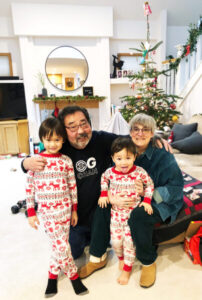
ーStrategically, costs can be prohibitive. For example, commercial kitchen equipment is expensive. With $30,000 for a walk-in refrigerator and $40,000 for a couple of wok burners, you are quickly getting into hundreds of thousands of dollars. Add in tables, chairs, tableware, cookware, etc. and now we are into a million dollars.
I would like to reach out to retail and wholesale food suppliers and stores. For events, we would need free or reduced-cost wholesale produce and protein. We will also need many trained volunteers to keep costs down for fundraising and long-term sustainability.
I have initiated four fundraisers so far. The first was sponsored by chefs Douglas and ET through Serious Pie Restaurant where cook Maisie Stewart-Cook prepared a four-course meal based on what her Filipina grandmother made for her.
We later held two events at Hannyatou: a coursed dinner by Grayseas Pies and another by myself with “yaki onigiri” (grilled rice balls) and “ochazuke” specials. Lupo and Kamonegi have contributed $1 per cocktail from events. Our most recent effort involved connecting Musang restaurant owner Melissa Miranda with a retirement fundraising event for outgoing ICHS CEO Teresita Batayola.
Looking ahead, a community-centered, culinary space is what I would like to help create and I am excited to partner with all to bring it to life!
• Spread shiokoji over a salmon filet or pieces (I make my own shiokoji but I also use Blue Mountain shiokoji, available at local gourmet stores or online)
• Cover and refrigerate 4-24 hours
• In a smoker or grill, smoke low (180º F) for about an hour
• Raise temperature to 250º F
• Remove when salmon reaches 125º F
• Serve with rice or ochazuke (rice in green tea)

